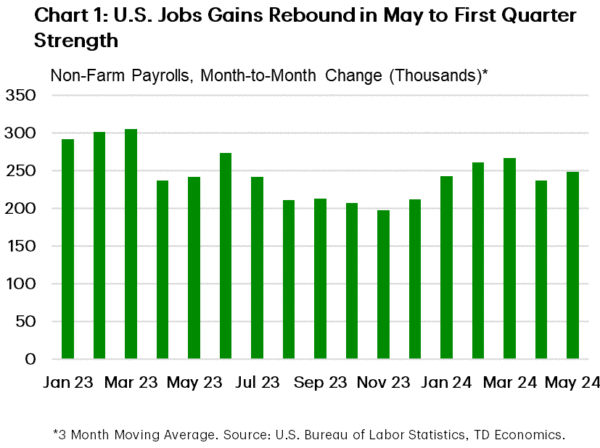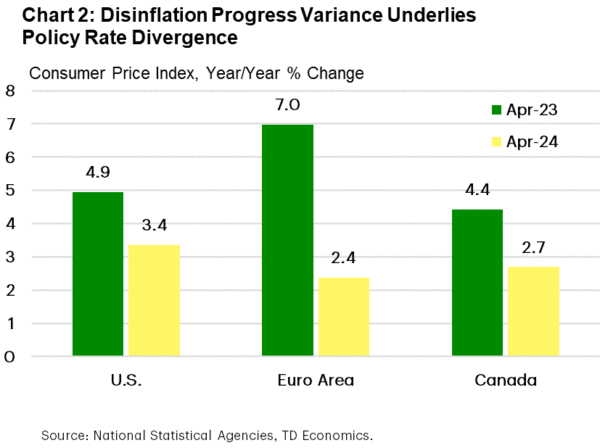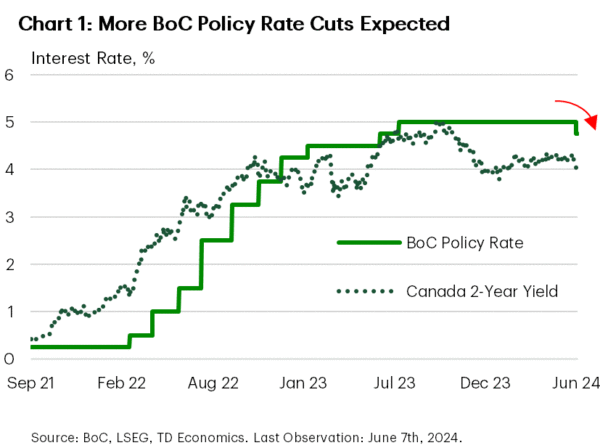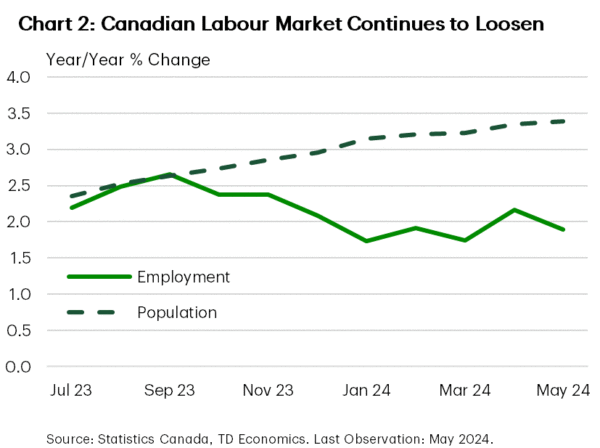U.S. Highlights
- The U.S. economy added 272k jobs in May, while the unemployment rate ticked up to 4.0%.
- The ISM Purchasing Managers’ Indexes showed manufacturing activity continued to contract in May, while services activity returned to growth.
- Central banks in Canada and Europe started to cut interest rates this week, which has heightened the focus of markets on the guidance expected from next week’s Federal Reserve meeting.
Canadian Highlights
- The Bank of Canada (BoC) cut its policy rate by 25 basis points this week (to 4.75%) – the first cut in four years.
- Canadian employment growth showed a 27k gain in May, but the unemployment rate continued to rise to 6.2%. The labour market has loosened on the back of rapid population increases.
- The path forward for the BoC is clear. With economic growth and inflation subdued, we expect the central bank to cut interest rates further in September and December this year.
U.S. – Labor Market Resilience Highlights Global Policy Rate Divergence
The economic calendar this week was backloaded, with Friday’s employment report for May dominating headlines. This week also saw two G7 central banks start cutting interest rates. Rate cuts by the European Central Bank and Bank of Canada raised market hopes that similar moves stateside were not far off. Treasury yields fell on the week, with the 10-Year yield down 9 basis-points (bps), while equities remained buoyant, with the S&P 500 rising to 1.4% as of the time of writing.
May’s jobs report showed that the economy added 272k jobs last month, exceeding consensus expectations and accelerating relative to the month prior (Chart 1). The unemployment rate ticked up modestly to 4.0% – it’s highest level in over two years – partly owing to a decline in the more volatile household survey employment metric. On aggregate the labor market remains solid, with broad-based contributions to non-farm payrolls in May, which helped to push up average hourly earnings. However, the uptick in the unemployment rate combined with the normalization in the job opening rate in April point to likely cooling moving forward.
Earlier in the week, we received an update on activity in the manufacturing and service sectors from the ISM Purchasing Managers’ Index reports. Manufacturing activity contracted for a second consecutive month, with growth in production and raw material prices continuing to decelerate as new orders fell sharply. In contrast, the services sector expanded, with the index reaching its highest level in nine months in May after contracting briefly in the month prior. With both indexes at levels consistent with the pre-pandemic period and survey respondents citing continued headwinds from high interest rates, the Federal Reserve should be in a position to ease policy later this year.
The Federal Reserve’s international counterparts began this process this week, with the Bank of Canada and the European Central Bank both lowering their policy rate by 25 bps. Inflation has cooled further outside the U.S. (Chart 2), as U.S. economic resilience slowed this progress over the past few months. However, officials in Canada and Europe emphasized that monetary policy easing would be implemented on a gradual basis, with future decisions dependent on the evolution of price growth trends moving forward.
Markets will now be waiting anxiously for the Federal Reserve’s decision next week. Although no change in policy is anticipated, the FOMC will publish updated forecasts in its Summary of Economic Projections (SEP). These will provide some guidance on the Fed’s expectations for interest rates. The prior SEP outlined expectations for 75 bps of cuts in 2024, but more recently market pricing has shifted closer to expecting roughly 50 bps after the persistence of inflation in the first quarter. Next week’s CPI report for May will provide some insight into the Fed’s progress on returning inflation to the 2% target, but it will likely be at least a few months before the Fed will possess the necessary confidence in the trajectory of inflation to reduce the policy rate.
Canada – Canada – Let’s Just Enjoy the Moment
The Bank of Canada (BoC) cut its policy rate by 25 basis points this week (to 4.75%), recognizing the easing in inflationary pressures that we have been harping on for all of 2024 (Chart 1). This was welcomed news for an economy that has been stuck in a rut for the better part of the last two years. Canadian employment confirmed this, as the unemployment rate rose to 6.2% (from 6.1%), even though jobs rose 27k in May.
The BoC found the confidence it needed to become the first G7 central bank to cut its policy rate. The bank had plenty of justification for cutting rates. GDP for the first quarter came in at about half the rate of population growth, making it the sixth negative GDP per capita print in the last seven. The bank could also point to the drop in underlying inflation, with the 3-month average of the BoC’s core inflation rates below the 2% target. This points to further deceleration in the annual core inflation rate in the months ahead. Not only that, but the Canadian job market has also continued to cool.
The unemployment rate has risen by 1.4 percentage points, from its low of 4.8% in 2022. This rise has occurred as population growth has well eclipsed the ability for firms to absorb workers (Chart 2). This trend continued in May. Employment growth was easily outpaced by a 98k increase in the working age population and a 55k increase in the number of people engaged in the workforce. Consequently, the number of unemployed workers has increased by 36% in the last two years. This is the largest increase in unemployment outside of recession. The rapid normalization in the job market has increased our confidence that wage growth will ease (from still high levels) over the remainder of this year.
Chart 2 shows year on year population (15+) and employment growth from July 2024 to May 2024. It show population growth will exceeding employment.
The road to future rate cuts is clear for the BoC. The policy rate is still restrictive and will continue to weigh on economic growth and inflation. Only about half of mortgage holders have renewed at higher rates. As more renew over 2024 and 2025, the impact on disposable income will prevent an acceleration in consumer spending even with BoC rate cuts. This means that the first rate cut seen this week won’t be the last.
That said, the BoC is likely to proceed cautiously. It doesn’t want to stoke the housing market, which has typically responded with a recoil whenever the BoC gives the market some interest rate relief. For this reason, we expect the central bank to pause in July, before cutting again in September and December. This means that Canada’s policy rate is going to fall further below the U.S.’s. The spread between the BoC overnight rate and the U.S. fed funds rate could widen to 100 to 125 basis points by year-end. This is within the range seen over the last three episodes of policy divergence, but the effect is likely going to be felt on the Canadian dollar, which we expect will push towards the 70 U.S. cent level over the second half of 2024.


















